Header logo
header top contact widget
periodontal plastic surgery
The “Risk vs. Reward” of Oral Health
Posted on Jun 25, 2024 by William J. Claiborne, DDS MS
Risk versus reward.
This is a phrase that’s often associated with decision-making, such as stock market investments. While certain strategies can increase the potential for “reward,” there is still an element of “risk” in losing part or all of the investment.
As a periodontist in Asheville, I see this in how it relates to decisions in dentistry. This is the case in replacing lost teeth. As a periodontal specialist, I place many dental implants in patients who’ve lost teeth that likely could have been kept had the patient made different decisions.
I also see this is in the decision of patients to have a crown (“cap”) placed on teeth. When a dentist recommends a crown, it is typically to keep the existing tooth structure intact and protected. So, when a tooth that’s been filled and needs yet another filling, the dentist may advise crowning the tooth instead. This preserves the remaining structure by avoiding the “risk” of tooth from breaking off.
Or, when a tooth shows signs of fracture(s), crowning may prevent the tooth from the need for removal. This is because a tooth that eventually breaks below the gum line can no longer be saved. Once removed, tooth replacement brings on an entirely new set of decisions, and costs.
Your general dentist’s goal, like yours, is to help you achieve and maintain a healthy smile. He or she wants you to keep your natural teeth or, if tooth loss does occur, replace them in a way that supports your overall oral health. A periodontist can be a strong team player in this goal.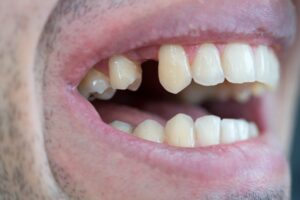
A periodontist is a dentist who specializes in the prevention, diagnosis, and treatment of periodontal disease and in the placement of dental implants. A periodontist is also a specialist in reshaping gum tissues, for reasons that may include esthetics as well as maintaining oral wellness.
I place many dental implants and am a proponent of them as a superior tooth replacement option. However, as ideal as an implant is, there is nothing as good for your oral health as natural teeth. This is why it’s so important to keep them. This may, for certain teeth, require the placement of a crown.
A periodontist may be involved in certain aspects of treatment to optimize a patient’s results and success level while minimizing discomfort. For instance, a periodontist may work with your general dentist to help save a tooth from removal when a tooth has broken close to the gum line. This is accomplished through crown lengthening procedures where gum tissues are removed to expose more of the tooth. This may be able to make sufficient tooth structure available to support a crown.
Crown lengthening is also beneficial in sealing gum tissues surrounding a tooth at its base. By securing the tissue around the tooth or crown, bacterial entry is avoided and the risk for periodontal (gum) disease decreased. This is especially beneficial in cases where gum tissues have receded, exposing sensitive tooth root sections that are easily affected by oral bacteria.
In some cases, gum tissue height can be corrected by careful removal in a procedure known as a gingivectomy. To enhance the appearance of a smile with an esthetically-pleasing smile line, combined with the placement of crowns, the tooth-to-gum ratio is rebalanced.
This is what is often referred to as a “gummy smile.” Crown lengthening is a common method that teams your general dentist with a periodontist to create a smile that looks natural and is beautifully flattering.
Another look at the risk-reward consideration, the “risk” of not caring properly for oral health can easily upend the “reward” of having a healthy smile. Regular dental check-ups and a thorough at-home oral hygiene regimen can prevent the development of cavities and periodontal disease.
When oral bacteria levels in the mouth are not managed, the teeth and gums pay the price, often through the need for costly treatment that may have been prevented. Periodontal disease is the nation’s leading cause of adult tooth loss.
Research has also found that the inflammatory bacteria of gum disease can enter the bloodstream, triggering or worsening a long list of serious health problems. These include heart disease, stroke, high blood pressure, diabetes, arthritis, memory loss, some cancers, impotency and Alzheimer’s disease.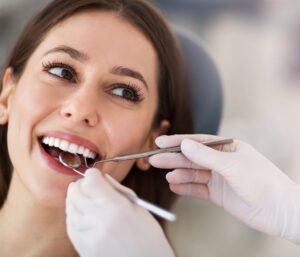
Although gum disease can exist without obvious signs or symptoms, the most commonly noticed are:
• Red, swollen or tender gums
• Seeing blood in the sink when brushing
• Receded gums
• Loose or separating teeth
• Pus pockets on gum tissues
• Sores in the mouth
• Persistent bad breath
As a periodontist in Asheville, we want everyone to know the benefits of a healthy, confident smile. Maintaining healthy gums and keeping your natural teeth is important to every individual.
If your gum health needs improvement or there are signs of gum disease, we can structure a program that restores healthy gums and helps you maintain your oral health between visits.
For those who have already experienced tooth loss, we are happy to discuss the process to replace them with dental implants. These are the closest thing to the natural teeth you had and will restore stability and dependable biting and chewing. Too, dental implants are designed to last a lifetime, making them an excellent investment.
With proper measures, you can enjoy healthy gums and natural teeth throughout your lifetime. Call 828-274-9440 to schedule a periodontal examination or ask for a consultation to get to know us. A referral to our office is not required.
If dental fear or anxiety has kept you from receiving regular dental care, please ask us about oral or I.V. sedation (“twilight sleep”). Both are administered safely with patient comfort always a priority.
What Can A Periodontist Do For You?
Posted on May 13, 2024 by William J. Claiborne, DDS MS
In meeting someone for the first time, a common question is “What do you do?” Telling them that I am a periodontist often gets followed by another question: “What does a periodontist do?” The long version, according to the American Academy of Periodontology, is:
“A periodontist is a dentist who specializes in the prevention, diagnosis, and treatment of periodontal disease, and in the placement of dental implants. Periodontists are also experts in the treatment of oral inflammation. Periodontists receive extensive training in these areas, including three additional years of education beyond dental school. They are familiar with the latest techniques for diagnosing and treating periodontal disease, and are also trained in performing cosmetic periodontal procedures.”
Choosing this dental specialty is achieved by an understanding that it will require many years of education. A periodontist begins by completing 4 years of college (undergraduate training) followed by another 4 years in dental school to earn a doctorate. The periodontal specialty then requires another 3-4 years before completing the stringent requirements for a specialty certification in periodontics.
What can all of this in-depth education and advanced skill level do for you?
Let’s begin with the diagnosis and treatment of all stages of periodontal (gum) disease. According to the Centers of Disease Control & Prevention (CDC), it is estimated that over 47% of Americans have some level of gum disease, which is also the leading cause of tooth loss. That’s nearly half of our population.
In addition to a healthy smile, the health of your gums can impact your overall health. By keeping the bacteria of advanced gum disease, known as periodontitis, you lower your risks of a long list of serious health problems that have been shown connected to gum disease bacteria. These include heart disease, stroke, diabetes, arthritis, Alzheimer’s disease, some cancers, preterm babies, and erectile dysfunction (ED).
A periodontal specialist is also a leading choice in the selection and placement of dental implants. With specialized skills, a periodontist is especially respectful to oral tissues as sensitive layers that have an important role in the appearance of a smile and the health of teeth. Utilizing these skills, a periodontist can help to minimize incisions while effectively treating each area in the mouth.
When it comes to the selection of the implant system best for you, our speciality also understands the complete spectrum of all implant types. Some implant systems offer a non-removable (“fixed”) option with others functioning with removable teeth.
Proper selection of your dental implants can also help to keep treatment fees to a minimum. This is because some implants can support more than one tooth and others are designed to support a full arch of replacement teeth. Because treatment fees are based on the number of implants required, your tooth replacement goals may be within a more manageable budget with fewer implants needed to accomplish your goals.
Reshaping gum tissues is also part of our specialized skills. The gum tissues are designed to provide a tight seal around the base of teeth and block bacterial entry to the sensitive tooth root area. When oral bacteria are able to penetrate beneath the gum line, they can cause inflammation to tender gums and attack the structures that support natural teeth.
In a procedure known as a gingivectomy, we are able to reposition or graft gum tissues over the area of recession to restore a healthy seal and protect the tooth structures below the surface.
In some cases, we are also able to save a natural tooth when the tooth breaks near the gum line. In a procedure known as crown lengthening, a periodontist can sometimes expose enough of the tooth structure for the placement of a crown. By preventing the need for the tooth’s removal, the patient is able to avoid the extensive costs and potential upkeep of replacing it.
When it comes to a smile’s appearance, a periodontist is also the go-to. In smiles that have an uneven line of gum tissues, meaning that some teeth have more gum showing than others. This up-and-down line of gum tissue creates a jumbled look. Crown lengthening can alter the height of these tissues prior to placement of a crown (‘cap’) to provide a more flattering smile line.
Another benefit of the skills of gum recontouring are the correction of a “gummy smile.” In this, the patient has too much gum tissue bordering the tops of teeth, making the smile line unbalanced. Using the gingivectomy procedure, a periodontist can lower the height of gum tissues, which is generally followed by placement of crowns.
Here, our Western North Carolina periodontal dental office features some of the most advanced technology in dentistry. Many of these features are not available in other dental offices elsewhere. Some of these include: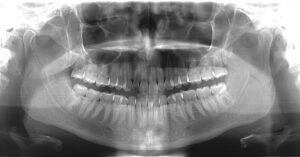
LANAP With PerioLase MVP 7 (Laser-Assisted New Attachment Procedure) – an advanced protocol that efficiently and effectively treats advanced gum disease with the added advantages of a dental laser. This offers a non-surgical alternative for patients with moderate to severe periodontal disease. LANAP treatment has also been found to stimulate bone regrowth in damaged areas.
3-D Cone Beam Imaging – used for diagnoses and treatment planning, giving clear views of the upper and lower jaw, used for intricate review of sagittal, axial, and coronal planes, locating and tracking nerve canals optimizes implant placement.
CareStream Cone Beam Computer Tomography Imaging – provides enhanced tomography that interacts with 3D imaging for exceptional detail and range.
CS 3600 Intraoral Scanner – This scanner quickly and comfortably captures digital impressions without the need for bulky, goopy trays! Through this process, we are able to create precision models or appliances (crowns, inlays, onlays, bridges, orthodontic appliances and aligners, custom abutments). The scanner can also reach difficult–to–access areas in the patient’s mouth for superior results with improved patient comfort.
Computerized Dental Implant Placement – allows for pre-surgical positioning of dental implants using a 3D model of the patient’s jaw. Once the implant type is selected, a template is developed for optimal treatment success, even for complex cases.
Sedation Dentistry – When dental fear or anxiety causes people to delay or avoid having dental treatment, we offer oral or IV sedation. Oral sedation is a pill that helps patients relax. It also has an amnesiac effect, leaving most with little or no memory of treatment afterward. I.V. sedation (also known as “twilight sleep”) places the patient in a deeper sleep state and erases memory of the procedure.
Through our extensive menu of treatments offered, it’s easy to see that our main goal is to provide patients with a comfortable and positive experience within our specialized skills. We believe this helps patients truly appreciate the advantages of a healthy smile and understand how our involvement can create a healthier, more confident individual.
I also feel it’s important that people are aware of the signs and symptoms of periodontal disease, which are:
• Red, swollen or tender gums
• Seeing blood in the sink when brushing
• Receded gums
• Loose or separating teeth
• Pus pockets on gum tissues
• Sores in the mouth
• Persistent bad breath
If any of these are present, please know that the condition will only worsen without treatment. And, early treatment can minimize treatment needs and costs.
Call 828-274-9440 if you have questions or wish to arrange a consultation discuss your individual needs (or those of a smile you love!). Our Asheville periodontal dental office staff will be happy to help you!
Reshaping Gum Tissues To Protect Oral Health & Enhance Smiling Appearance
Posted on Mar 21, 2024 by William J. Claiborne, DDS MS
When people think about the appearance of their smiles, it’s typically the teeth that are the focus. Everyone wants a smile that enhances appearance, instills self-confidence and gets compliments. Yet, the appearance of a smile involves more than just teeth. The “frame” of gum tissues that arch the teeth most visible in a smile have a lot to do with how a smile looks.
As a periodontal specialist in Asheville, NC, part of my specialty involves the treatment of all stages of periodontal (gum) disease, the placement of dental implants, and the contouring of gum tissues. Gum contouring is generally done for esthetic reasons but may also be advised for oral wellness.
Gums most often pull away from the base of teeth (or “recede”), exposing darker areas of the tooth. This darker area is part of the tooth’s root and highly vulnerable to damage. Recession also causes teeth to look longer and expose darker tooth root areas of the tooth. Being sensitive to hot or cold – causing a sudden jolt of pain – is often the final warning sign that the gums are not protecting tender root segments of the tooth.
Gum recession is commonly due to:
• Gum disease, which destroys gums tissues, causing them to loosen their firm grip around the base of teeth. This enables oral bacteria to penetrate beneath the gum line, reaching vulnerable bone and tissues.
• Over-vigorous toothbrushing can wear away precious gum tissues that surround the base of teeth. When using a back-&-forth scrubbing motion, or a hard toothbrush, gum tissues can be scrubbed off. Too, using abrasive substances to brush (such as baking soda) not only wear down gum tissues, they wear away tooth enamel.
• The aging process lessens hydration in the body. Because the gum tissues are moist layers that require continual hydration (supported by saliva), oral dryness can cause the gums to draw up as they become drier. Unfortunately, this creates more challenges in maintaining healthy teeth.
While gum recession is an oral health concern, it is a cosmetic issue as well. For an attractive smile, teeth should be arched by a balanced level and shape of gum tissues. When there is too much gum tissue showing above teeth or varying heights of gums arching teeth, the height and symmetry of gum tissues can be corrected by a periodontist.
For example, in a gummy smile, too much of the gum line is visible. This makes teeth look short and draws the eye to the gums rather than the teeth. Gum tissues should complement teeth with a balanced line of gum tissues. While a gummy smile is not generally problematic for one’s oral health, many people find it makes them “hold back” on smiling fully.
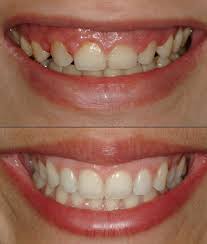
Before & After Of A Gummy Smile
The procedure to correct a gummy smile is a gingival lift, also known as a gum lift or gum contouring. This in-office procedure is performed to reduce and reshape highly visible gums.
In our Western NC periodontal dental office, we use a dental laser to perform a gingival lift. Our dental laser gives a precision line while only removing specific areas of the gums, leaving all surrounding tissue unharmed. This allows us to reshape the gums to create better balance in the smile.
A laser gingival lift also offers patients a more comfortable experience since it causes very little pain and therefore requires only topical anesthesia. In addition, laser treatments result in almost no bleeding and tissues tend to heal more quickly than after traditional surgery.
We also perform gum grafting that recovers areas where gum recession has occurred. This helps to protect the tooth roots and improves the appearance of the smile.
In gum grafting, we normally take a small area of tissue from the roof of the mouth and place it in the area of recession. When there is not sufficient tissue available, a graft may be from a donor source. The graft is attached to the natural gum tissue and gently sutured into the position where it corrects a smile’s appearance and reduces further recession and the potential for gum disease.
Several teeth may be involved in gum grafting when used to even out the gum line or reduce the risk of gum and bone collapse after a tooth has been lost. In these cases, cosmetic gum surgery is beneficial in reshaping excess gum and bone tissue. It also reduces sensitivity from exposed roots to hot or cold foods.
As a periodontist, I most commonly see gums that cover too much of the teeth as being due to genetics. When gums fail to cover sufficiently over the base of teeth, it’s typically the cause of recession, which can occur from several reasons (as listed prior). Regardless of why it has occurred, our goal is to provide the patient with the most healthy and esthetic outcome in a procedure that is comfortable, successful, and requires minimal healing time.
In our Asheville periodontal dental office, we offer some of the most advanced dental technology available. In addition to amazing imaging, such as Cone Beam 3D imaging, we provide Laser-Assisted New Attachment Procedure (or LANAP). This is a cutting-edge protocol to more efficiently and effectively treat periodontitis (advanced gum disease) with the PerioLase® MVP-7™ laser. Treatment is minimally invasive and helps to minimize both discomfort and recovery time. It has also been found to stimulate bone regrowth in damaged areas.
Additionally, our office offers both oral and I.V. sedation (“twilight sleep”) for complete relaxation during treatment. Sedation is administered safely by a doctor of anesthesia to provide optimal safety and comfort.
If finances have kept you from seeking out the care you need or the beautiful smile you desire, feel free to contact our friendly staff and arrange a consultation appointment. During this time, we can discuss the best options for you, cost estimates, and predicted treatment time.
We can also review several payment plans that make treatment affordable through extended, interest-free payment periods with no down payment required. These often help our patients enjoy their confident, new smiles while making easy monthly payments that are budget friendly.
Call 828-274-9440 to schedule.
Achieve Smile Goals With A Periodontist
Posted on Dec 11, 2023 by William J. Claiborne, DDS MS
If you’re like me, I’m usually looking at the end of each year feeling like there are several things I wanted to accomplish for the year, but kept putting them off until I ran out of time.
For some people, their oral health and appearance goals are on this list, with some who keep moving the goals to the next year and the next. These goals may include:
• Improving the appearance of a smile
• Having a “cleaner” mouth with fresh breath, etc.
• Replacing missing teeth
• Getting past fear or anxiety of dental visits
If you have one of these on your list, you may be surprised that a periodontal specialist can play a major role in helping you achieve your goals. And, because of the advanced skill level of a periodontist, your comfort, time in treatment and overall results can make the process easier for you.
Many general dentists and other dental specialists refer their patients to a for their specific skills. A periodontist is a dental specialist who is the expert in caring for the gum tissues in your mouth and in the placement of dental implants.
The majority of patients arrive because of periodontal (gum) disease. Common symptoms are red, swollen and tender gums. It often causes gum that bleed easily (often noticed when brushing teeth) and persistent bad breath.
Gum disease (sometimes referred to as ‘perio’ disease) only worsens without treatment. It is the leading cause of adult tooth loss. Additionally, it has been linked to the development or worsening of a long list of serious health problems elsewhere in the body.
Because the inflammatory bacteria disease can enter the bloodstream through diseased gums, their presence can activate conditions that are seemingly unrelated to oral health. Yet, the connection is severe. These health problems include stroke, heart attack, Alzheimer’s disease, dementia, preterm babies, some cancers, arthritis, diabetes, and erectile dysfunction (ED).
In our Asheville periodontal dental office, we are able to treat all stages of gum disease to restore your oral health and minimize the risk of tooth loss. For those who have developed gum disease because they’ve been afraid of dental visits, we offer oral and IV sedation (“twilight sleep”).
Sedation is administered safely by a doctor in anesthesia who uses advanced safety equipment. Our priority is always patient comfort with their safety equally so.
Too, our advanced technology is able to minimize treatment time with amazing results. For example, LANAP (Laser-Assisted New Attachment Procedure) combined with PERIOLASE MVP-7 is designed to efficiently and effectively treat periodontitis (advanced gum disease) with the advantages of a dental laser. This offers non-surgical treatment for patients with moderate to severe periodontal disease. LANAP treatment minimizes discomfort and has a quick recovery time. It has also been found to stimulate bone regrowth in damaged areas.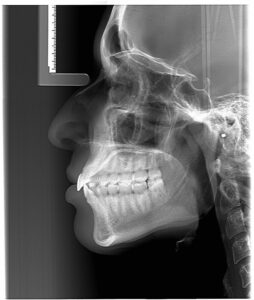
When tooth loss has occurred (whether from gum disease, an accident, or due to genetics), our NW NC dental specialty office also works with a number of dentists in the diagnosis and placement of dental implants.
With over 40 different implant systems, the one suited best for you depends on factors that an experienced dentist must take into consideration. For example, the number of implants you need and how much jaw bone mass exists.
For individuals who have lost a great deal of bone, specific implant types may be recommended. Some, like the “All On 4” implant system, uses specially designed implants which are placed at specific angles.
Bone loss can also be overcome by incorporating a bone rebuilding process into treatment. This is done prior to implant placement and does not require a bone graft. In many cases, we can apply a bone rebuilding material that restores ample bone mass.
The same is true when the sinus cavity will be too close to the proximity. This can be remedied through a “sinus lift.” We provide complete services of these procedures as well as dental implant placement – all performed with advanced skills and technology, such as our Cone Beam 3D imaging.
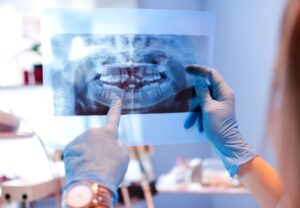 These images are ideal in diagnosis and treatment planning by giving a clear view of the mandible and maxilla (upper and lower jaw). Cone beam radiographs provide images in sagittal, axial, and coronal planes. This makes it possible to locate and trace the mandibular nerve canal for pre-surgical planning for an ideal implant position. Patients are exposed to only minute levels of radiation through a process that is fast and comfortable.
These images are ideal in diagnosis and treatment planning by giving a clear view of the mandible and maxilla (upper and lower jaw). Cone beam radiographs provide images in sagittal, axial, and coronal planes. This makes it possible to locate and trace the mandibular nerve canal for pre-surgical planning for an ideal implant position. Patients are exposed to only minute levels of radiation through a process that is fast and comfortable.
When the enhanced appearance of a smile is being sought, a periodontist also plays a part in helping to create a balanced smile line. In the procedure known as “crown lengthening,” the arch of gum tissues over teeth visible in a smile can be repositioned. This is done in a procedure known as a gingivectomy.
A gingivectomy is also performed to repair a “gummy smile.” This is when too much gum tissue shows above the teeth most visible in a smile. While the condition is not detrimental to oral health, some individuals seek to have it corrected by a periodontist.
Get the coming year started with your smile goals achieved! Call our Asheville periodontal dental office to schedule a consultation. Our friendly staff can help you arrange this private time together by calling 828-274-9440.
Recent Posts
Categories
Archives
- September 2024
- August 2024
- July 2024
- June 2024
- May 2024
- April 2024
- March 2024
- February 2024
- January 2024
- December 2023
- November 2023
- October 2023
- September 2023
- August 2023
- July 2023
- June 2023
- May 2023
- April 2023
- March 2023
- February 2023
- January 2023
- December 2022
- November 2022
- October 2022
- September 2022
- August 2022
- July 2022
- June 2022
- May 2022
- April 2022
- March 2022
- February 2022
- January 2022
- December 2021
- November 2021
- October 2021
- September 2021
- August 2021
- July 2021
- June 2021
- May 2021
- April 2021
- March 2021
- February 2021
- January 2021
- December 2020
- November 2020
- October 2020
- September 2020
- August 2020
- July 2020
- June 2020
- May 2020
- April 2020
- March 2020
- February 2020
- January 2020
- December 2019
- November 2019
- October 2019
- September 2019
- August 2019
- July 2019
- June 2019
- May 2019
- April 2019
- March 2019
- February 2019
- January 2019
- December 2018
- November 2018
- October 2018
- September 2018
- August 2018
- July 2018
- June 2018
- May 2018
- April 2018
- March 2018
- February 2018
- January 2018
- December 2017
- November 2017
- October 2017
- September 2017
- August 2017
- July 2017
- June 2017
- May 2017
- April 2017
- March 2017
- February 2017
- January 2017
- December 2016
- November 2016
- October 2016
- September 2016
- August 2016
- July 2016
- June 2016
- May 2016
- April 2016
- March 2016
- February 2016
- January 2016
- December 2015
- November 2015
- October 2015
- September 2015
- August 2015
- July 2015
- June 2015
- May 2015
- April 2015
- March 2015
- February 2015
- January 2015
- December 2014
- November 2014
- October 2014
- September 2014
- August 2014
- July 2014
- June 2014
- May 2014
- April 2014
- March 2014
- February 2014
- January 2014
- December 2013
- November 2013
- October 2013
- September 2013
- August 2013
- July 2013
- June 2013
- May 2013
- April 2013
- March 2013
- February 2013
- January 2013
- December 2012
- November 2012
- October 2012
- September 2012
- August 2012
- July 2012
- June 2012


